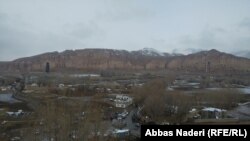BAMIYAN, Afghanistan -- The Afghan official in charge of looking after the archeological remains in Bamiyan Valley, a UNESCO World Heritage site, says they are threatened with complete annihilation.
Ahmad Hossein Ahmadpur, the head of the government’s cultural department in the central province of Bamiyan, says the sites, which range in age from 1,500 to 2000 years old, now face extinction.
“What is really worrying is that the erosion and destruction of various archeological sites around Bamiyan Valley are increasing every day,” he told Radio Free Afghanistan on January 24. “Most of them require urgent repairs and preservation to prevent further damage.”
According to UNESCO, eight separate sites in Bamiyan Valley in Afghanistan’s Hindu Kush Mountains constitute the region’s unique heritage. Collectively, they are recognized as a World Heritage site.
The most famous monuments in Bamiyan were two large Buddha statues carved into niches in the valley’s cliffs 15 centuries ago. They are still significant global sites even after the Taliban blew up the statues in 2001.
Other sites such as caves housing Buddhist monasteries, chapels, and sanctuaries where wall paintings from the Gandharan period are now disappearing. Similar sites extend into the branches of Bamiyan Valley where they face rapid decay. The fortress of Shahr-i Gholghola and other remains of fortifications in Bamiyan Valley are similarly threatened by environmental degradation and a lack of repairs and proper care.
“The cultural landscape and archaeological remains of Bamiyan Valley represent the artistic and religious developments which from the first to the 13th centuries characterized ancient Bakhtria, integrating various cultural influences into the Gandhara school of Buddhist art,” UNESCO said.
In Bamiyan, Ahmadpur says his requests for preserving the region’s cultural heritage have fallen on deaf ears in the capital, Kabul, where senior officials must approve requests for funding.
“We have been told the work will be carried out soon, but nothing concrete has happened on the ground yet,” he said.
To discuss the future of Bamiyan’s statues, the Afghan government, UNESCO, and Tokyo’s University of the Arts convened a “closed technical meeting” followed by a public symposium in Japan last year.
A statement by UNESCO after the events hinted at restoration work.
“There were four technical proposals from Italy, Germany, and Japan concerning the reconstruction of the Bamiyan Eastern Buddha statue, which led to a solid first step in serious reflection on potential reconstruction/rehabilitation of the Bamiyan Buddha cliff,” the October 11 statement said. “The Afghan authorities will establish a committee to review and discuss these proposals and any new proposal related to reconstruction.”
While the restoration of Bamiyan Buddhas has been debated both inside Afghanistan and internationally after the demise of the Taliban regime in late 2001, residents of the historic valley and local officials are eager for the actual restoration work to begin.
Abubakar Siddique wrote this story based on Radio Free Afghanistan correspondent Abbas Naderi’s reporting from Bamiyan, Afghanistan.







